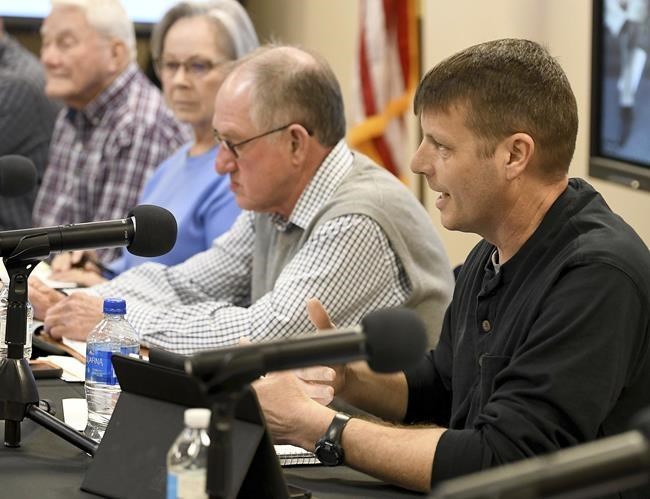Scott Sutherland - Thursday
The Weather Network
Nearly two decades after the Larsen B ice shelf collapse, satellites captured another collapse of sorts, as warm winds flowing over the Antarctic Peninsula disintegrated the sea ice inhabiting the waters the ice shelf once covered.
Back in March of 2002, the Larsen B ice shelf — 3,200 square kilometres of floating glacial ice attached near the tip of the Antarctic Peninsula — broke apart and collapsed into the sea. In the weeks leading up to this event, satellites spotted numerous melt ponds collecting on the ice shelf's surface due to warm summer temperatures over the region. Then, in just three days, starting on March 2, satellite imagery captured dramatic views as nearly the entire ice shelf fractured and surged out into the Weddell Sea.

© Provided by The Weather NetworkSatellites capture rapid disintegration of ice in the Larsen B embaymentTwo views from NASA's Terra satellite from 2002. On February 14 (left) Larsen B was still intact, but numerous melt ponds are clearly visible on the surface. Just over a month later, the same view (right) shows nearly the entire ice shelf having collapsed into a flow of icebergs and newly freed sea ice. Credit: NASA Worldview
Now, close to 20 years after that event, we've seen a second collapse of the ice in that part of the world.
Once an ice shelf collapses, it's unheard of to see it regenerate. Unlike sea ice, which melts and refreezes each year, an ice shelf forms when the leading edge of a glacier pushes out over water, becoming a direct extension of the land ice. Icebergs break off the edges of ice shelves from time to time simply due to the stresses of ocean currents and sea ice collisions. The sheet ice is replenished from the glacier on land, though. So it would take decades or longer for an immense ice shelf to regenerate, even without the continued stresses of global warming.
However, starting in 2011, a swath of sea ice set up in the Larsen B embayment. This was not the thick glacial ice that was there a decade before. Instead, it was 'landfast' ice — comparatively thin sea ice that became fastened to the shoreline.
"It was the first time since the early 2002 shelf collapse that the Larsen B embayment was seen to freeze up and stay frozen through multiple austral summers," Christopher Shuman, a glaciologist with NASA's Goddard Space Flight Center, said in NASA Earth Observatory's Image of the Day post from February 2.
Year after year, this landfast ice persisted in the embayment. As captured by orbiting satellites, it even took on the shape (if not the thickness) of the original ice shelf. However, throughout December 2021 and the first half of January 2022, satellites recorded a repeat of the same pattern that occurred in 2002. Numerous blue melt ponds were spotted on the surface of the landfast ice. Then, in a matter of days, the ice disintegrated and drifted away.

© Provided by The Weather NetworkSatellites capture rapid disintegration of ice in the Larsen B embaymentTwo views of the same region of the Antarctic Peninsula from January of 2022, before the collapse of the Larsen B landfast ice and after. Credit: NASA
On January 11, days before this multi-year ice broke apart, the National Snow and Ice Data Center (NSIDC) noted that the extensive meltwater ponds resulted from a series of wind storms that crossed the Peninsula since December. Like the Chinook winds of southern Alberta, when wind storms pass over the Antarctandes — the mountain range that stretches along the northern part of the Peninsula — it results in warm, dry air flowing down the lee side of the range. In Antarctica, these are called Foehn winds.
Each of these wind storms had a strong impact on the melt season across the Peninsula. For example, in late December, the amount of melting detected was roughly three times greater than the average for that same period from 1990 to 2020.

© Provided by The Weather NetworkSatellites capture rapid disintegration of ice in the Larsen B embaymentA series of wind storms passing over the Antarctic Peninsula produced strong melting periods throughout December and January. Credit: L. Lopez, NSIDC, M. MacFerrin, CIRES and T. Mote, University of Georgia
A series of wind storms passing over the Antarctic Peninsula produced strong melting periods throughout December and January. Credit: L. Lopez, NSIDC, M. MacFerrin, CIRES and T. Mote, University of Georgia
Meltwater ponds profoundly affect the stability of the ice they rest upon, whether it is sea ice or a thick ice shelf. The water from these ponds erodes the ice underneath them, weakening the overall structure and making it easier for the ice to fracture and break apart.
CONCERNS FOR SEA LEVEL RISE
The disintegration of this landfast ice will not directly impact sea level rise. This is for the same reason a new iceberg, or even the collapse of an ice shelf, does not contribute much to this particular aspect of climate change. The ice was already floating before it broke away from the land, so its weight was displacing the water underneath it. Therefore, its contribution to ocean levels was already accounted for.
There is an indirect concern stemming from this event, though.
According to NASA Earth Observatory: "This summer's breakup of the sea ice in the embayment is important because — unlike the meltwater from an ice shelf, icebergs, and sea ice (already floating) — the meltwater from a glacier adds to the ocean's volume and contributes directly to sea level rise. With the sea ice now gone, "the likelihood is that backstress will be reduced on all glaciers in the Larsen B Embayment and that additional inland ice losses will be coming soon," said Shuman.
THE LARSEN ICE SHELF
The Larsen ice shelf is an expanse of thick glacial ice along the eastern shoreline of the Antarctic Peninsula. After it was completely mapped out, it was divided into four different sections — Larsen A, B, C, and D.

© Provided by The Weather NetworkSatellites capture rapid disintegration of ice in the Larsen B embaymentThis view of the Larsen A and B embayments includes annotations showing the past extents of the ice shelves, and includes an inset map of the entire Larsen ice shelf. Credit: NASA Earth Observatory
Larsen A was the northernmost of these ice shelves. It collapsed in January of 1995. Larsen B held on until 2002, before it disintegrated.
Larsen C made headlines in 2017 when iceberg A68 broke away from its leading edge in July of that year.
The largest iceberg in the world at the time, A68 ended up floating out to sea and got as far as South Georgia Island by late 2020. There, it crashed into the island shelf and then shattered into numerous pieces.

© Provided by The Weather NetworkSatellites capture rapid disintegration of ice in the Larsen B embaymentThe remainder of A-68a, along with other large pieces that also broke off of A-68, on January 11, 2021 near South Georgia Island. (NASA Earth Observatory image by Lauren Dauphin, using VIIRS data from NASA EOSDIS LANCE, GIBS/Worldview, and the Suomi National Polar-orbiting Partnership)
So far, the rest of Larsen C and all of Larsen D currently remain intact.





